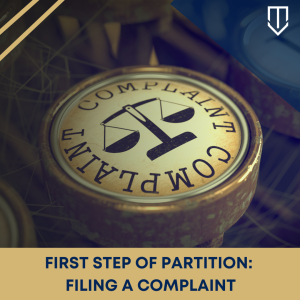 A “TIC” Agreement is a contractual agreement between tenants in common to real property. Because each tenant in common is a co-owner of the property, these agreements can help spell out the rights of each, preventing future disputes over payment or occupation. And, if the dispute cannot be prevented, the agreement, acting as a binding contract, provides a clear guideline for a judge to use in a court action, ensuring that the lawsuit moves along as quickly as possible.
A “TIC” Agreement is a contractual agreement between tenants in common to real property. Because each tenant in common is a co-owner of the property, these agreements can help spell out the rights of each, preventing future disputes over payment or occupation. And, if the dispute cannot be prevented, the agreement, acting as a binding contract, provides a clear guideline for a judge to use in a court action, ensuring that the lawsuit moves along as quickly as possible.
That being said, an imperfect TIC agreement can wind up doing more harm than good in certain situations. If it fails to include a partition waiver, for example, one co-owner can actually attempt to force a sale of the entire property outright.
As such, it is important for any prospective co-owner of real property to choose the right attorney for the job. At Underwood Law Firm, our attorneys are well-versed in the law of co-ownership, and we know the best ways to tackle the disputes that accompany it. Our team has the legal acumen and skills necessary to help you achieve your ownership goals.
 California Partition Law Blog
California Partition Law Blog


 In California, a person can claim title to a piece of real property that they are not a titleholder to through adverse possession. Adverse possession requires a person to be in use of a particular piece of real property for the required statutory period. An adverse possessor, however, does not become the titleholder of a piece of property merely by using the property. Certain elements are required for a claimant to acquire title through adverse possession. The requirements for adverse possession are codified in the California Code of Civil Procedure section 323.
In California, a person can claim title to a piece of real property that they are not a titleholder to through adverse possession. Adverse possession requires a person to be in use of a particular piece of real property for the required statutory period. An adverse possessor, however, does not become the titleholder of a piece of property merely by using the property. Certain elements are required for a claimant to acquire title through adverse possession. The requirements for adverse possession are codified in the California Code of Civil Procedure section 323.
 A motion to determine title is a motion to the court requesting that the court establish title to a piece of real property. Typically, a motion to determine title shows up in the court as a quiet title action. A quiet title action is brought when a litigant seeks to establish that they have an ownership interest in the subject property and refute any adverse claims against the litigant. It follows that to prevail on a motion to determine title; one must show that they hold some ownership interest in the subject property.
A motion to determine title is a motion to the court requesting that the court establish title to a piece of real property. Typically, a motion to determine title shows up in the court as a quiet title action. A quiet title action is brought when a litigant seeks to establish that they have an ownership interest in the subject property and refute any adverse claims against the litigant. It follows that to prevail on a motion to determine title; one must show that they hold some ownership interest in the subject property.  Yes, but only in specific circumstances. When thinking of lawsuits, most people associate them with individuals. John may sue Mary for battery, for example. But this isn’t always the case. A large part of the law is devoted to virtual representation because some people, like minors, simply cannot file suit.
Yes, but only in specific circumstances. When thinking of lawsuits, most people associate them with individuals. John may sue Mary for battery, for example. But this isn’t always the case. A large part of the law is devoted to virtual representation because some people, like minors, simply cannot file suit.  When there are two or more owners of a piece of real property who are unable to come to an agreement on how to divide the property, any co-owner of the subject property may petition the court to partition the property. This is known as a partition action. Generally, the decision of a court to partition the property is merely the first step in the partition process. Although a partition action may sound quite simple, it is a complex process that requires extensive accounting and patience.
When there are two or more owners of a piece of real property who are unable to come to an agreement on how to divide the property, any co-owner of the subject property may petition the court to partition the property. This is known as a partition action. Generally, the decision of a court to partition the property is merely the first step in the partition process. Although a partition action may sound quite simple, it is a complex process that requires extensive accounting and patience.  In California, property subject to a trust can be partitioned, though with some additional wrinkles to the regular partition process. Because trusts can often involve successive estates with future and present property interests, litigants should take care to understand the law regarding trusts before beginning such an action.
In California, property subject to a trust can be partitioned, though with some additional wrinkles to the regular partition process. Because trusts can often involve successive estates with future and present property interests, litigants should take care to understand the law regarding trusts before beginning such an action.  Co-ownership of property brings with it many rights and duties under the law. These rights and duties can vary depending on whether co-owners hold property as
Co-ownership of property brings with it many rights and duties under the law. These rights and duties can vary depending on whether co-owners hold property as  Slander of title is quite the unique cause of action. As the name implies, it involves defamatory or slanderous activity but not against any person or personal interest. Instead, a slander of title involves activity that calls the state of your title into doubt (by, for example, filing an unwarranted lis pendens) that diminishes the value of your property.
Slander of title is quite the unique cause of action. As the name implies, it involves defamatory or slanderous activity but not against any person or personal interest. Instead, a slander of title involves activity that calls the state of your title into doubt (by, for example, filing an unwarranted lis pendens) that diminishes the value of your property.  In most cases, no. Instead, the statute of limitations most frequently bars a partition action when a party’s rights to the property have lapsed due to an ouster.
In most cases, no. Instead, the statute of limitations most frequently bars a partition action when a party’s rights to the property have lapsed due to an ouster.